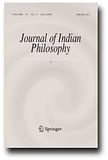Journal of Indian Philosophy 2011 - 39,6
Journal of Indian Philosophy
Journal of Indian philosophy / Editor-in-Chief: Phyllis Granoff. - Vol. 39,6. - Dordrecht [u.a.] : Springer [u.a.], 2011.
ISSN 0022-1791 (Printausg.)
ISSN 1573-0395 (Online-Ausg.)
URL: Homepage
URL: Online-Ausg. (Springerlink)
DOI: 10.1007/s10781-011-9126-z
Abstract: U. Vē. Cāminātaiyar (1885–1942) is arguably one of the most influential figures of the so-called “Tamil Renaissance” of the nineteenth and early twentieth centuries; his work has profoundly shaped the study of Tamil literature, both in India and the Euro-American academy, for more than a century. Among his many literary works is a long and incomplete autobiographical treatise known as Eṉ Carittiram, literally “My Life Story,” initially published in 122 installments between 1940 and 1942. What little scholarly attention this fascinating autobiographical narrative has received thus far has largely read the text as an artless, transparent documenting of South Indian literary culture in the late nineteenth century. Yet the text reveals substantial rhetorical art on close reading. Greater attention to Cāminātaiyar’s specific context and probable concerns when composing (and publicly publishing) Eṉ Carittiram suggests alternative ways of reading Tamil literary history and those texts that he first made widely available.
DOI: 10.1007/s10781-011-9125-0
Abstract: The Jains and their texts play a key role in the literary histories of the Tamil-speaking region. However, in their modern form, dating from 1856 to the present, these histories have been written almost exclusively by non-Jains. Driving their efforts have been agendas such as cultural evolutionism, Dravidian nationalism or Śaiva devotionalism. This essay builds on ideas articulated by the contemporary Tamil theorist K. Civatampi, examining how various models of periodization have frozen the Jains in the ancient past. Further, it will explore how this unfolding historical drama, which gloriously climaxes in Tamil literature, has attributed the Jains, as dramatis personae, merely a role in early Jain texts; their role as communities transmitting these texts has been ignored. In contrast to this typical pattern, this article will also introduce a literary history written in 1941 by the Jain A. Cakravarti Nāyaṉār (1880–1960). It will explore whether or not his voice, which emerged from within the same academic community contributing to the strange absence of Jains in the contemporary awareness of Tamil literary, was successful in finding another way for Jains of being heard, and for non-Jains, of listening.
DOI: 10.1007/s10781-011-9127-y
Abstract: The writing of literary histories of Tamil literature coincided with the practice of history itself as a discipline starting in the late nineteenth century. The historiographical practices conflated Tamil literary history, religious history, as well as notions of the Tamil nation, which led to such works becoming vitally important legitimising narratives that established the claim of self-defining groups within a new Tamil modernity. The absence of such a narrative also meant the erasure of a particular group, identifying itself as a caste or religious unit, or both, from Tamil history. It is in the light of these cultural and political stakes that we must view the textual and hermeneutical strategies of an old, Tamil, religious group, the Śrīvaiṣṇavas, to position themselves anew in the mid-twentieth century, in what they saw with anxiety as a Tamil, Ṡaiva Age.
DOI: 10.1007/s10781-011-9145-9
Abstract: The paper aims to determine the identity of an unnamed opponent in a passage of the first chapter of the Prasannapadā whose school affiliation eluded traditional Tibetan scholars and is disputed by modern scholars. The individual(s) in question, whose fundamental ontological views are made evident in the passage’s opening objection as presented by Candrakīrti, has/have alternatively been identified as the Mādhyamika Bhāviveka, as representatives of the Naiyāyika school and, following Stcherbatsky, as Dignāga and/or later members of his epistemological-logical tradition. Although textual evidence adduced by authors of recent publications has been viewed as supportive of the hypothesis that the interlocutor is Dignāga, the general nature of this evidence and awareness of Dignāga’s ontological presuppositions suggest that the matter requires reconsideration.
Ähnlich
- Sambhasa 2013 - 30
- Sambhasa 2011 - 29
- Studies in Indian philosophy and Buddhism 2011 - 18
- Journal of Indian Philosophy 2011 - 39,4-5
- Journal of Indian Philosophy 2011 - 39,3
- Journal of Indian Philosophy 2011 - 39,2
- Journal of Indian Philosophy 2011 - 39,1
- Asian Philosophy 2011 - Vol. 21,1
- Journal of Indian Philosophy 2010 - 38,2-4
- Journal of Indian Philosophy 2010 - 38,1

